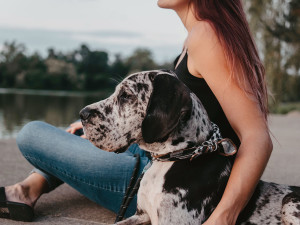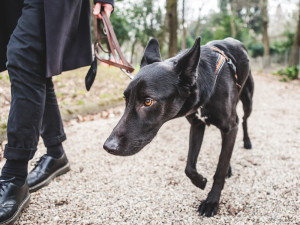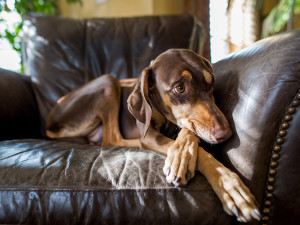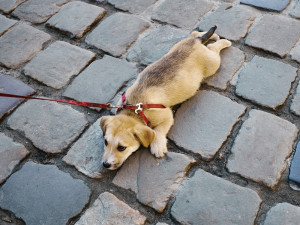Why Does My Dog Turn Into a Statue on Walks?
Suddenly, your neighborhood sidewalk has some new installation art: your frozen dog.
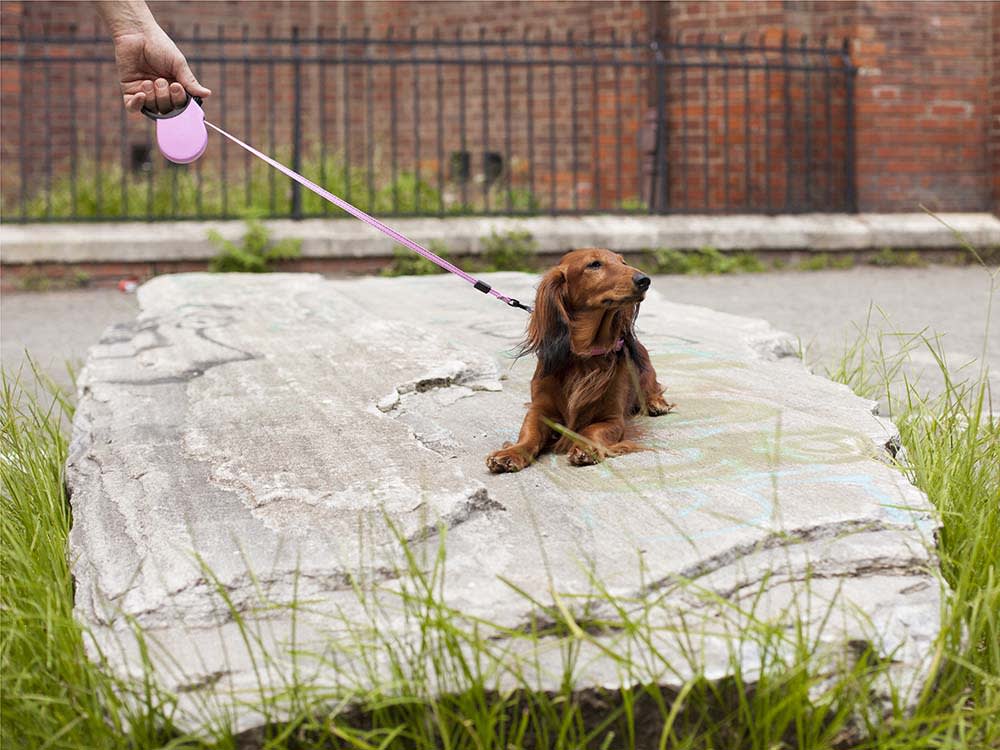
share article

Your pet wants you to read our newsletter. (Then give them a treat.)
As a dog behaviorist, I often get asked, “Is what my dog doing normal?” Top topics that pop up regularly are: rolling in garbage or poop, eating poopopens in a new tab, chasing their tailopens in a new tab, chewing their pawsopens in a new tab, humpingopens in a new tab, crotch-sniffingopens in a new tab, and, well, the list goes on.
The answer to most of these? “Yes, they are all perfectly normal behaviors” — they’re just not activities that we humans are familiar with or particularly comfortable with. Sometimes, I’m asked if it’s normal for a dog to stop short and freeze completely while on a walk, like your neighborhood’s newest statue. The answer depends on the severity of the situation. Here’s everything you need to know.
How Do Dogs React to Fear?
If your dog freezes multiple times during a walk, that can be pretty distressing — for both you and your dog. There can be many reasons for freezing. To modify the behavior, you need to understand the underlying issue, which is most likely fearopens in a new tab. Dogs tend to react in four ways when they feel uneasy. Commonly referred to as the Four Fs of Fear by dog experts, these include:
Fight
Flight
Freeze
Fooling around
Almost everyone has heard of the fight or flight response — the tendency to either stand and confront the source of your fear (fight) or to run from it (flight). Both of these reactions can be observed regularly by humans and animals alike.
The two lesser-known reactions are to freeze or fool around. Fooling around is a displacement behavior. It is a behavior that is inappropriate to the situation but diffuses the tension and relieves stress. If a dog is presented with an object or person they have not seen before, they may dance around, hot-stepping or barking at the unknown and somewhat scary new thing.
Why do dogs freeze?
Freezing is exactly as it sounds. Your dog will freeze, relying on stillness to go undetected, like a deer in headlights. Dogs commonly exhibit freezing when reacting to stress or fear. Once they’re still, they assess the situation and then decide what to do next. Is it safe to move on or could the danger still be in the area? If they continue to feel under threat, they may refuse to walkopens in a new tab on.
Dogs have extremely sensitive noses, amazing hearing, and an incredible line of vision. They may smell, hear, or see something that you’re not aware of. Maybe they can hear the neighborhood bully dog in the distance, smell the treat lady’s biscuits, or see kids in hoodies that remind them of past trauma.
Interestingly, dogs can freeze without you even noticing. The freeze, assessment, and decision to continue is so rapid that the dog has moved on before the freeze is noted. This assessment will include the dog’s current circumstances, their well-being, and who they are with. The confidence that a dog has in their human is similar to that of a child with a parent. Dogs who wholeheartedly trust their human and their ability to defend are far less likely to freeze while in their presence.
If your dog is showing signs of severe fearfulness, I suggest contacting a canine behaviorist and dog traineropens in a new tab to understand the triggers and work on building your dog’s confidence. Telltale signs of severe fearfulness include: tail between legsopens in a new tab, shaking, flitting from one spot to another, and distress peeing.
Other Freezing Triggers
Another common cause of freezing could be learned behavior. For example, if you try to get your dog to walk by giving them a treatopens in a new tab, your dog will start to think freezing results in a treat and will repeat the behavior. Stop rewarding the behavior and they’ll stop freezing.
Of course, there could be other reasons your dog is freezing on walks. Maybe they’re tired and want to go home, they’re thirsty and want a drink, their feet are aching, or they’re stubborn and want to walk a different routeopens in a new tab. They may remember the bread that was left out for the birds at the house two streets up and hope it will be there again today.
How to Prevent Your Dog From Freezing on Walks
Building confidence is the best solution. It could be that your dog needs to feel more confident with you. Or, it could be that they need to feel more confident when outside. Or, it could be a combination of the two. Building confidence will reduce freezing and encourage your dog to continue to walk — but this can be a long game, depending on how deep-rooted the fear is.
Make a diary of your walks to find patterns in your dog’s freezing. Is there a certain route they do not like? Are there certain noises that trigger them? Does daytime or nighttime produce more freezing? Do they freeze more with one member of the family than another?
Gathering this information means you can start to create a walk that avoids the triggers. Why stress your dog out unnecessarily? Building confidence occurs much more quickly if a dog is not already stressed and anticipating fear before they have even left the house.
Do not force your dog to walk in a direction that they’re scared to go in. You will gain more trust by taking a different route than forcing them to walk on. You might need to only cross the street but to your dog, you are addressing their discomfort and taking control of the situation. As trust builds in you and freezing subsides, you can start to tackle the source of the fear.
The bottom line: Dogs live in the moment. If a dog freezes, they’re doing so for a reason. Work with your dog to understand that reason and then address it. Walks are supposed to be enjoyable for both you and your dog. After all, they’re an enjoyable way for you both to exercise, socialize, and bond.

Emma Bowdrey, ISCP
Emma Bowdrey is an ISCP-trained Dog Trainer based in Prague, where she lives with her adopted greyhound, Swift. Emma has worked with dogs since gaining her qualification in Canine Behaviour & Psychology and now runs her own business - Four Long Legs. Emma uses positive reinforcement methods to make each hound a happy one.
